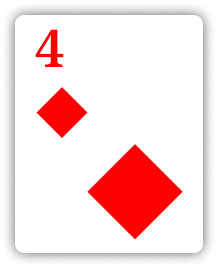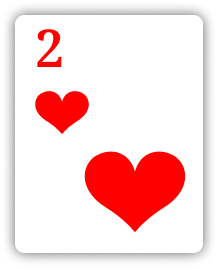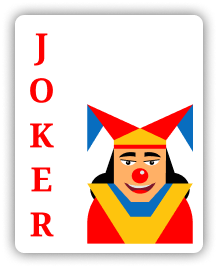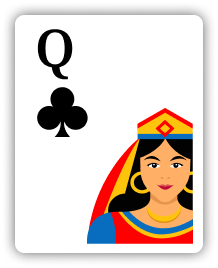Kalooki is a variant form of Contract Rummy, played by 4 - 7 players. This variant of contract rummy is played with multiple decks
of 54 standard playing cards: 52 playing cards + 2 jokers.
The objective is to have the lowest cumulative score or always go out by laying down all of your cards. The penalty value of the
cards, if left in a player's hand when someone goes out, are:
| Cards |
Value |
| Joker |
50 |
| Black Ace |
15 |
| King, Queen, Jack, Ten |
10 |
| 2-9 |
Face Value |
| Red Ace |
1 |
| Call & Contract Error Penalty |
50 |
Deal & Contracts
Nine hands (or “deals”) make up a game set
Players take turns to deal (“give out”) the cards, the first dealer being chosen at random. Nine hands (or "deals")make up a
game set, and the winner is the player who has the lowest cumulative score at the end of the game set.The cards are dealt
out one at a time, the number of cards dealt to each player depends on the game being playedas shown in the table below.
The next card is turned face up to start the discards pile, and the remaining “undealt”cards are stacked face down beside it,
to form the draw pile.
| Deal Number |
No of cards shared to each player |
Contract (Number) |
Contract (Text) |
| 1 |
9 |
333 |
Threes Threes |
| 2 |
10 |
334 |
Two Threes, One Four |
| 3 |
11 |
344 |
Two Fours, One Three |
| 4 |
12 |
444 |
Three Fours |
| 5 |
12 |
3333 |
Four Threes |
| 6 |
13 |
3334 |
Three Threes, One Four |
| 7 |
14 |
3334 (Half & Half) |
Two Threes, Two Fours |
| 8 |
15 |
3334 |
One Three, Three Fours |
| 9 |
16 |
4444 |
Four Fours |
Threes & Fours
Diplaying your contracts
A “three (3)” is a set of three or more cards of the same rank, such as :
The suits of the cards do not matter and duplicates can be included.
A ”four(4)” is a run of four or more consecutive cards in the same suit, such as:
Aces can be high or low but can only beused at the end of a run, not in the interior, such as:
When more than one four is put down by one player, they must be of different suits, and when more than one three is put down
byone player, they must be of different ranks.
In a ”three(3)” there must be at least two genuine (non-joker) cards, so in a minimum "three" of three cards you can only include
one joker., such as:
In a ”four(4)”, jokers cannot be used for consecutive cards.
Jokers that have been used in a three or four can never been removed from that combination. A joker used in a three cannot be
moved at all. When a joker used in a four, it can in certain circumstances be moved to the end of the sequence by the holder of
the real card, but never moved to a different three or four - there is no possibility for the holder of the real card that the joker
represents to play it and take the joker in exchange, as in some other rummy games.
Game Play
A player's turn
- The player to the dealer's left begins and the turn to play passes clockwise. A player's turn consists of:
- Drawing one card from the top card of the draw pile or the top of the discard pile;
- Optionally laying down all cards; (this will end the game and double or bend the table)
- Discarding any one card (other than a joker) face up on the discard pile.
- Jokers cannot be discarded, but apart from that there is no restriction on what card you may discardfrom your hand at the
end of your turn. It is legal to discard the same card that you just picked up.
Calling
- If you have not yet laid down any cards, and you want to take a card discarded by another player when it is not your turn to
play next, youcan call the card. The player whose turn it is to play has two options
- The player whose turn it is gives the top discard to the player who called it. The calling player takes the discard and must
also draw one extra card from the stock, but cannot lay down any cards or discard at this time. The caller will from now
on have two extra cards in their hand. Theplay then reverts to the player whose turn was interrupted by the call, who
must draw from the stock, and continue the turn in the usual way.
- If the player whose turn it is has not yet laid down, they have the right to take the discard for themselves, rather than
giving it to the caller anddrawing from the stock; the call then has no effect
- Calling is subject to the following rules.
- If several people try to call the same card, the person who calls first gets the card, assuming that the person whose turn
it is allows the call.It becomes ava.
- There can only be one call per turn: the card underneath the called card cannot be called - anyone who wanted it should
have called it when itwas first discarded.
- Each player is allowed a maximum of three calls per hand (deal). Calls that were not allowed by the player whose turn it
was or which wereunsuccessful because another player called first do not count towards the three.
- A player who has laid down cards can no longer call.
Laying Down(Lay)
The first cards you lay down must satisfy the contract for the game being played. For example, in game 3, you mustlay
down a group of three or more equal ranked cards, plus sequences of four or more cards in two different suits. Ifyou are
not able to do this, you cannot lay any down any cards yet.
End of Game Play
Score
- As soon as a player goes out by getting rid of all their cards, the play ends. The other players sum the card value of
the cards they have in their hands and add the result to their cumulative total score.
- When a player manages to go out on the same turn that they first lay down cards, this is known as down and out, and the
other players score double card values for that round.
- At the end of the set of nine deals, the player who has the lowest cumulative score is the winner
- ”Score” - the cumulative sum of penalties and card values of cards held by the player at the end of the game.
- This is known as down and out, and the other players score double card values for that round.
Penalties
Over Call Penalty (See Calling)
It sometimes happens that a player will carelessly call more than three times in one round. If this happens, the player in question
is penalized (the penalty points), not allowed to make any more calls or to refuse a call from player and is not allowed to bend the
table in that game.
Contract Error Penalty (see Threes & Fours, Laying)
It sometimes happens that a player who lays down cards is found not to have the required threes and fours for the current round,
the result is a contract error in that round. A contract error is the incorrect lay down that does not satisfy the contract for the
round being played; for example a contract error in a round is laying down three threes in round 4 when the round 4 contract is
three fours. For this error the player is penalized (the penalty points). The player is also not allowed to lay or bend the table in that
round. Play for that player continues with drawing one card from the top card of the draw pile stock or the top of the discard pile
and discarding any one card (other than a joker) face up on the discard pile.




























